Volume 28.3
September–December 2025
Full table of contents
ISSN: 1094-8074, web version;
1935-3952, print version
Recent Research Articles
See all articles in 28.3 September-December 2025
See all articles in 28.2 May-August 2025
See all articles in 28.1 January-April 2025
See all articles in 27.3 September-December 2024
Interested in submitting a paper to Palaeontologia Electronica?
Click here to register and submit.
Article Search
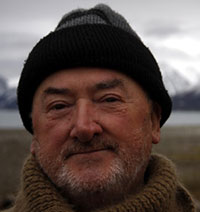 Jerzy Fedorowski
Jerzy Fedorowski
Institute of Geology
Adam Mickiewicz University
Maków Polnych 16
Pl-61-606, Poznań
Poland
jerzy@amu.edu.pl
Jerzy Fedorowski received his Ph.D. from Jagiellonian University (Cracov, Poland) in 1963 and is currently Professor Emeritus of Adam Mickiewicz University, Poznan, Poland, working part time in the Institute of Geology of that University. His main speciality is the taxonomy, phylogeny and palaeogeography of Upper Paleozoic rugose coral faunas, with emphasis on those from the Carboniferous and Lower Permian from various areas of the world. Recently, he has been involved in studies of early Viséan to Serpukhovian faunas of the Cantabrian Mts. (Spain), latest Viséan and late Bashkirian faunas of eastern Poland, early Bashkirian faunas of the Donets Basin (Ukraine), and Bashkirian to Moscovian faunas of Alaska.

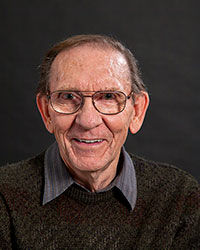 E. Wayne Bamber
E. Wayne Bamber
Geological Survey of Canada (Calgary)
3303-33rd Street N. W.
Calgary
Alberta T2L 2A7
Canada
wabamber@nrcan.gc.ca
E. Wayne Bamber received his Ph.D. from Princeton University in 1961 and is currently a research paleontologist at the Geological Survey of Canada in Calgary, Alberta, Canada. His main speciality is the taxonomy and biostratigraphy of Upper Paleozoic rugose coral faunas, with emphasis on those from the Carboniferous and Lower Permian of western and arctic Canada. Recently, he has been involved in studies of late Mississippian and early Pennsylvanian faunas of the southern Canadian Rocky Mountains and the Sverdrup Basin.

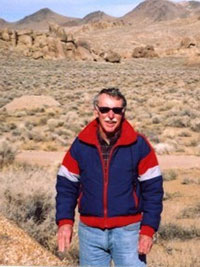 Calvin H. Stevens
Calvin H. Stevens
Department of Geology
San Jose State University
San Jose
California 95192
USA
calvin.stevens@sjsu.edu
Calvin H. Stevens is an expert on some aspects of Permian paleontology, stratigraphy and tectonics who got his Ph.D. at USC in 1963, and is now a professor emeritus at San Jose State University. His primary interests are Late Paleozoic corals and fusulinids, the sedimentology of Paleozoic shelf-margin rocks in eastern California, and interpretation of the Paleozoic history of allochthonous terranes in western North America.

FIGURE 1. Location map showing Blind Creek Limestone block (arrow); type locality of Heritschioides columbicum (Smith, 1935); modified from Danner et al. (1999, appendix 2, p. 4).

FIGURE 2. Heritschioides columbicum (Smith, 1935). 2.1-2.4, holotype GSC 9059. 2.5-2.7, paratype GSC 9060, 2.5, 2.6 - longitudinal sections. Scale bar applies to all images. Cardinal septa indicated by black dots. In this and all subsequent figures, all illustrations are of transverse sections unless otherwise indicated.

FIGURE 3. Heritschioides columbicum (Smith, 1935). Topotypes. 3.1, 3.3, topotype GSC 136094, 3.2, 3.4, 3.7, topotype GSC 124100, 3.2, 3.4 – successive cuts upward, 3.7 – longitudinal section, 3.5, topotype GSC 136096 – structural displacement, lower right. 3.6, topotype GSC 136096 – longitudinal section. 3.8, topotype GSC 136095 – longitudinal section. Scale bar applies to all images. Cardinal septa indicated by white and/or black dots.

FIGURE 4. Heritschioides columbicum (Smith, 1935). Topotypes. Immature corallites. Cardinal septa marked by arrows. 4.1-4.4, topotype GSC 136094, all images taken from same transverse section of colony. 4.5, topotype GSC 136095. Scale bar applies to all images.

FIGURE 5. Heritschioides columbicum (Smith, 1935). Differentiated morphology of dissepimentarium and peripheral sectors of septa. 5.1-5.7, 5.10, 5.11, topotypes. 5.1-5.3, 5.11, topotype GSC 136094, 5.11 – longitudinal section. 5.4, 5.7, 5.10, topotype GSC 124100. 5.5, 5.6, topotype GSC 135095. 5.8, holotype GSC 9059, A and B refer to adjacent loculi in biform morphology. 5.9, paratype GSC 9061. Scale bar applies to all images.

FIGURE 6. Heritschioides columbicum (Smith, 1935). Topotypes. Morphology of axial structure and its relationship to cardinal septum. 6.1, 6.8, topotype GSC 124100. 6.2, topotype GSC 136096. 6.3, 6.4, topotype GSC 136095. 6.5-6.7, topotype GSC 136094. Scale bar at the bottom applies to all images except 5-7. Cardinal septa indicated by black and/or white dots.
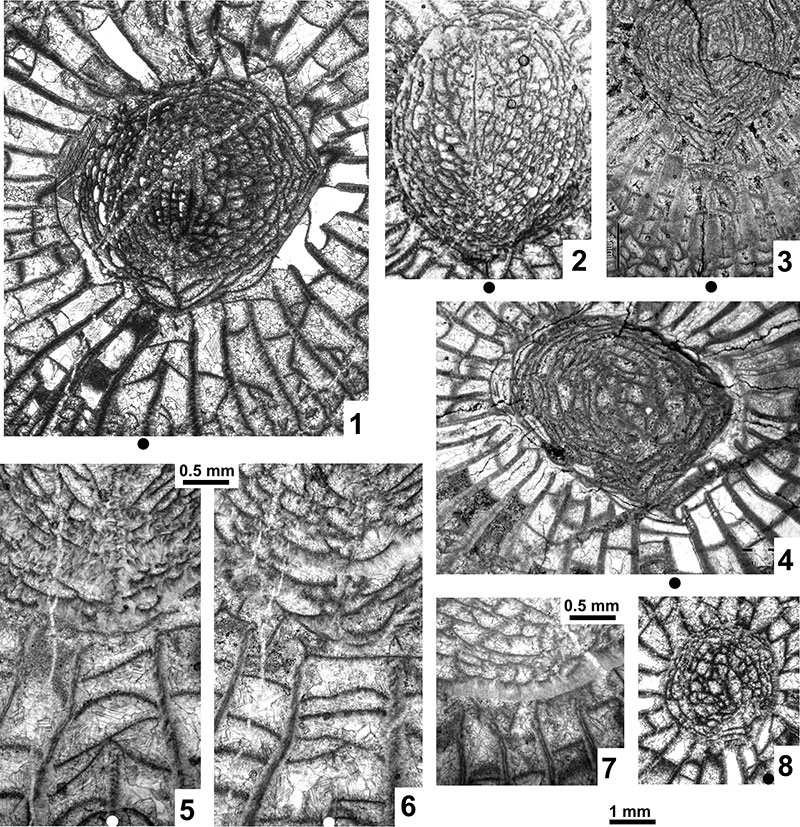
FIGURE 7. Heritschioides columbicum (Smith, 1935). Diagenetic alterations in microstructure of septa. 7.1-7.3, topotype GSC 136096. 7.4, topotype GSC 136095 longitudinal section, arrows indicate some of fan-forming trabeculae. 7.5, topotype GSC 136095, rudiments of septotheca recognizable. 7.6, topotype GSC 136094, septotheca recrystallized competely. 7.7, paratype GSC 9061, arrows indicate disruptions in septa.
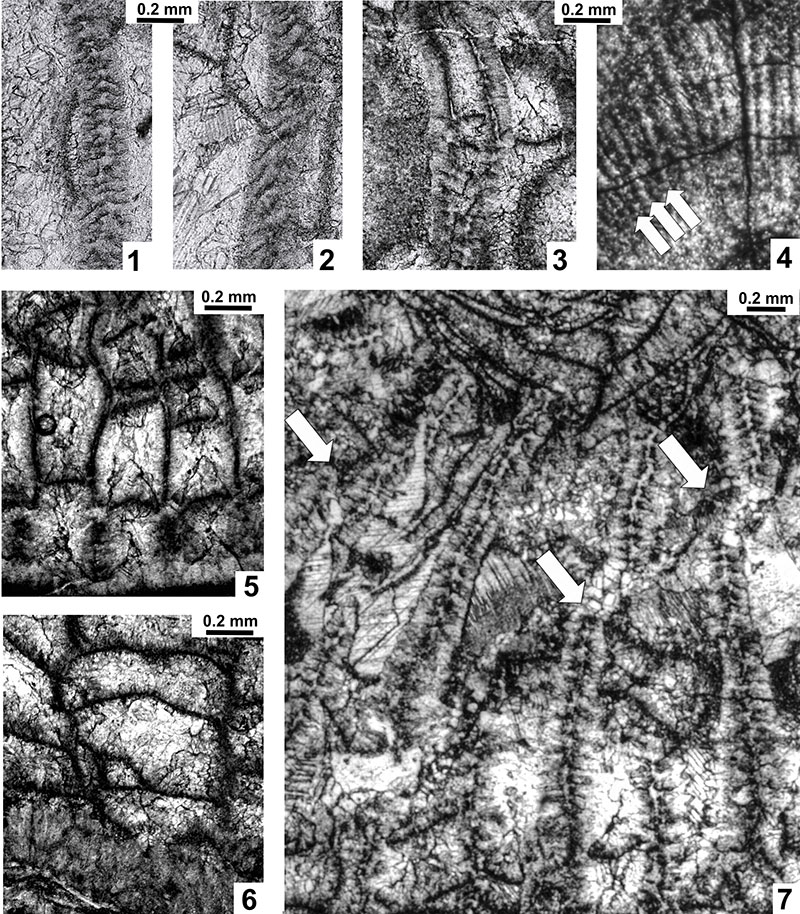
FIGURE 8. Heritschioides columbicum (Smith, 1935). Topotypes. Offsetting corallites. 8.1, topotype GSC 124100, 8.2-8.4, topotype GSC 136094, vertical distances between these three images approximately 1.1 mm. Scale bar applies to all images.

FIGURE 9. Heritschioides columbicum (Smith, 1935). Topotypes, computer drawings. 9.1-9.4, topotype GSC 124100 – successively more mature growth stages of offset; vertical distances between drawings indicated by arrows. 9.5-9.8, topotype GSC 136094 – successively more mature growth stages of two adjacent offsets (A and B). Cardinal septa marked by black dots. Vertical distances between thin sections approximately 1.1 mm. Scale bar applies to all drawings.
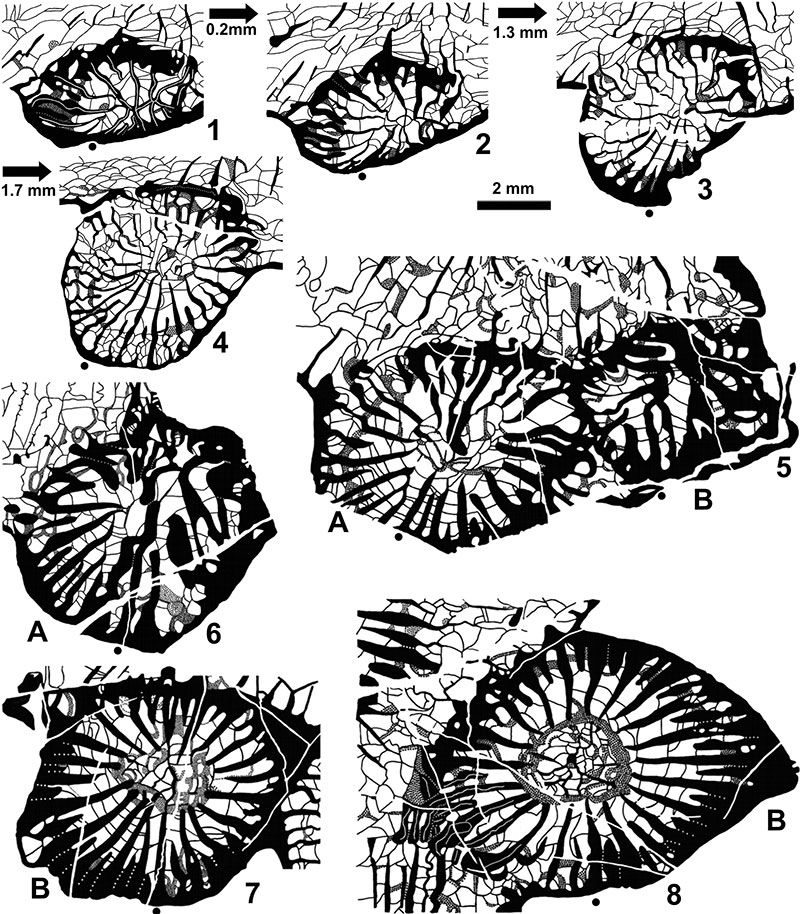
A revision of Heritschioides Yabe, 1950 (Anthozoa, Rugosa), latest Mississippian and earliest Pennsylvanian of western North America
Plain Language Abstract
The concept of the coral genus Heritschioides has had a complicated history. Originally, it was thought to be Permian in age and many Permian species, particularly in North America, were assigned to that genus. More recent work on associated microfossils, however, has shown that the type species is middle Carboniferous in age, and the detailed morphological study presented here confirms that all Permian species belong to different, unrelated genera. Heritschioides is especially interesting in that almost all known species of the genus occur in allochthonous terranes, which much later were amalgamated to the western margin of North America.
Resumen en Español
Revisión de Heritschioides Yabe, 1950 (Anthozoa, Rugosa): Misisipiense tardío y Pensilvaniense temprano del oeste de América del Norte
Los nuevos datos aportados por un estudio detallado de las colecciones tipo y topotipo de la especie tipo Heritschioides confirman el estatus único del género como colonial y portador de lamelas septales adicionales. Los microfósiles en la asociación establecen su edad como Serpujoviense tardío a Bashkiriense temprano. La estrecha conexión del septo cardinal a la lámina media y la estructura axial indica su pertenencia a la familia Aulophyllidae. Sin embargo, el papel inconsistente de los protoseptos en la formación de la lámina media es único para Heritschioides. Esta característica y la forma del crecimiento colonial permiten su asignación a una subfamilia separada, Heritschioidinae Sando, 1985 , la cual está estrechamente relacionada con la subfamilia Aulophyllinae. De acuerdo con los conocimientos actuales, la subfamilia Heritschioidinae únicamente está representada en las rocas que se encuentran a lo largo del margen occidental de América del Norte.
Palabras clave: Serpujoviense tardío-Bashkiriense temprano; coral colonial; ejemplares tipo; oeste de América del Norte; terranos alóctonos
Traducción: Enrique Peñalver
Résumé en Français
Une révision de Heritschioides Yabe , 1950 (Anthozoa , Rugosa) , de la fin du Mississippien supérieur et du tout début du Pennsylvanien inferieur à l'ouest de l'Amérique du Nord
De nouvelles données provenant d'une étude détaillée des collections type et topotype de l'espèce type de Heritschioides confirment le statut unique du genre en étant coloniale et portant des lamelles septales supplémentaires. Les microfossiles associés établissent son âge entre Serpukhovien supérieur et Bashkirien inferieur. La connexion proche de la cloison cardinale à la lamelle médiane et les structures axiales pointes vers la famille Aulophyllidae. Cependant, le rôle inconsistant de la protocloison dans la formation de la lamelle médiane est unique pour Heritschioides. Cette caractéristique et la forme de croissance coloniale permettent son affectation à une sous-famille distincte, Heritschioidinae Sando, 1985, qui est étroitement liée à la sous-famille Aulophyllinae. Jusqu'à présent, la sous-famille Heritschioidinae se trouve seulement dans les roches le long de la bordure ouest de l'Amérique du Nord.
Mots-clés : Serpukhovien superieur- Bashkirien inferieur; corail colonial; spécimens types; Ouest de l'Amérique du Nord; terrains allochtones
Translator: Kenny J. Travouillon
Deutsche Zusammenfassung
Eine Revision von Heritschioides Yabe, 1950 (Anthozoa, Rugosa), spätestes Mississippium und frühestes Pennsylvanium von Nordamerika
Neues Datenmaterial aus einer detaillierten Studie der Typen-und Topotypen-Sammlung der Typusart von Heritschioides bestätigen die einzigartige Stellung dieser Gattung als koloniales und spezielle Septumlamellen tragendes Taxon. Die assoziierten Mikrofossilien setzen das Alter auf spätes Serpukhovium bis frühes Bashkirium fest. Die enge Verbindung des cardinalen Septums mit der medianen Lamelle und die axiale Struktur weisen auf die Familie Aulophyllidae hin. Allerdings ist die widersprüchliche Rolle der Protosepten bei der Bildung der medianen Lamellen einzigartig für Heritschioides. Dieses Merkmal und die koloniale Wachstumsform erlauben die Zuordnung zu einer separaten Subfamilie, den Heritschioidinae Sando, 1985, die eng mit der Subfamilie Aulophyllinae verwandt ist. Bis jetzt war die Subfamilie Heritschioidinae nur aus Gesteinen entlang des westlichen Randes von Nordamerika bekannt.
Keywords: spätes Serpukhovium-frühes Bashkirium; koloniale Koralle; Typusexemplar; westliches Nordamerika; allochthone Terrane
Translator: Eva Gebauer
Arabic
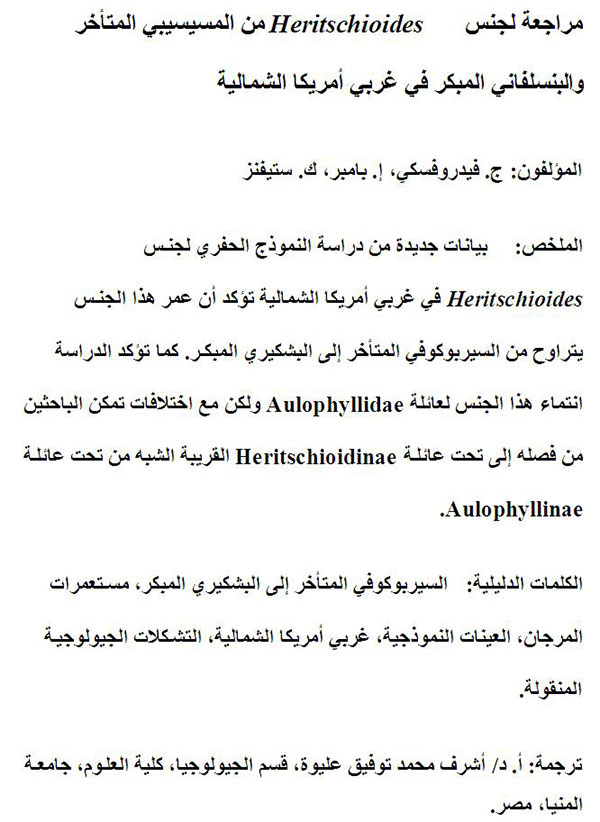
Translator: Ashraf M.T. Elewa
-
-
PE: An influential journal
 Palaeontologia Electronica among the most influential palaeontological journals
Palaeontologia Electronica among the most influential palaeontological journalsArticle number: 27.2.2E
July 2024





 A Review of Handbook of Paleoichthyology Volume 8a: Actinopterygii I, Palaeoniscimorpha, Stem Neopterygii, Chondrostei
A Review of Handbook of Paleoichthyology Volume 8a: Actinopterygii I, Palaeoniscimorpha, Stem Neopterygii, Chondrostei